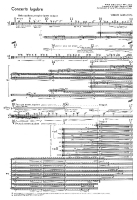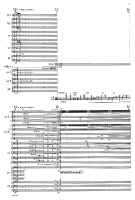Concerto lugubre for viola and orchestra (1975)
Concerto lugubre, fragment of a rehearsal during the 1976 Warsaw Autumn Festival (fragment of a television programme, "A music lover's Tuesday", 1976), performers: Stefan Kamasa - viola, Polish Radio and Television Symphony Orchestra, Jacek Kasprzyk - conductor
The Concerto for viola solo and orchestra with a rich percussion set was commissioned by the city of Nuremberg, where it was also premiered. It is a memorial concerto with some autobiographical origins. The dedication in the score – “In memory of my mother, who died in 1974” – is a clear indication of the personal reasons behind the writing of the work.
The composer explained the form of the work in the following manner:
I already knew the beginning of the Concerto, I knew the middle elegy with the drums as if over an open grave, I had written the final solos of the flute and the viola, as well as the final, dissonant, though slightly brightened up chords of the violins, covering a barely audible C major chord. I already had a musical “plot” of the piece, which led from a growing resistance and rebellion, through pain and horror to the final gentle sadness, quiet acceptance of the inevitable. I heard a persistent E flat note, the ever present central point of the work, as well as three chords containing the entire sound material used in the score vertically and horizontally.
It is difficult to unequivocally and unquestionably describe the structure of the work, because its musical narrative is continuous. Moments in which the sonic action stops completely are not a formal caesura (i.e. they do no signify the end of a given section), but, above all, serve a dramatic function. However, we can distinguish three larger fragments (movements) preceded by an introduction and crowned with a coda. This symbolic division stems from the emotional “plot” of the work as declared by Baird. The introduction (bars 1-10) brings in a restless mood, part one (bars 11-44) is dramatic, part two (bars 45-94) – elegiac, and part three (bards 95–150) – very aggressive. The climax of the entire piece is almost in accordance with the “golden ratio” principle and falls in the last section. It is released in a quiet coda heading for niente (bars 151-179). Such a formal arrangement brings to mind classical principles.
Concerto lugubre, Tadeusz Baird talking to Grzegorz Michalski (fragment of a television programme, "A music lover's Tuesday", 1976)
In three key chords Baird indicates the entire material of the work organised around the central note of E flat. These chords are presented by string instruments (in bars 12, 15 and 18), immediately after the introduction of the viola solo. These are: a ninth seven-note chord, a tenth nine-note chord and a twelfth eleven-note chord. By adding up these chords, we get the full chromatic material from B to F2. It is transformed qualitatively by means of articulation (e.g. sudden and violent rhythmic accents by the percussion, piano and harp, as well as short and robust strikes of the wind instruments) or selection of instruments (e.g. viola solo and alto flute carrying a sad, “improvised” melody). Some variety is also brought by dissonant or delicate chords as well as a kind of micropolyphony based on aleatory repetitions of cells comprising several notes. The sombre and mournful nature of Concerto lugubre is achieved thanks to the low, dark and vivid colour of the three dominant instruments – the viola, the alto flute and the timpani – and thanks to the changing tempo.
The noise-resembling nature of the Concerto was confirmed by the composer, who said:
I used sharp, even brutal sonic measures, harmonic chords, aleatory fragments etc. and yet – judging by the reaction of Polish and non-Polish audiences – I may have cut some ice with the listeners.
In an introduction to a performance of the work, Rafał Augustyn presented an evocative description of the work:
The viola concerto is – in accordance with its Italian title – a dark, sombre, austere composition. The sound of the viola’s low registers (Baird’s favourite in the piece); giving up ostentatious orchestral colourfulness; a characteristic prime motif – consistently kept in the foreground – with a brilliantly used interval of a second; austere figuration; clear, measured sounds of chords in the brass; modest, ascetic cantilenas and deep pizzicatos – all this contributes to a dense, vivid expression. All this is music which contains more psychology than literature, but in which the main component is – music.
For Baird the work was very important. As he said:
The first large work I can be really proud of is Goethe-Briefe, followed by the Concerto lugubre and Scenes.
Very interesiting characteristics of the most important properties of Concerto lugubre can be found in Krzysztof Knittel's comments:
Tadeusz Baird commented the collaboration with Jacek Kaspszyk before Concerto lugubre's premiere in 1976 (in an TV interview with Grzegorz Michalski):
In Kaspszyk's memoirs this story draws as follows:







